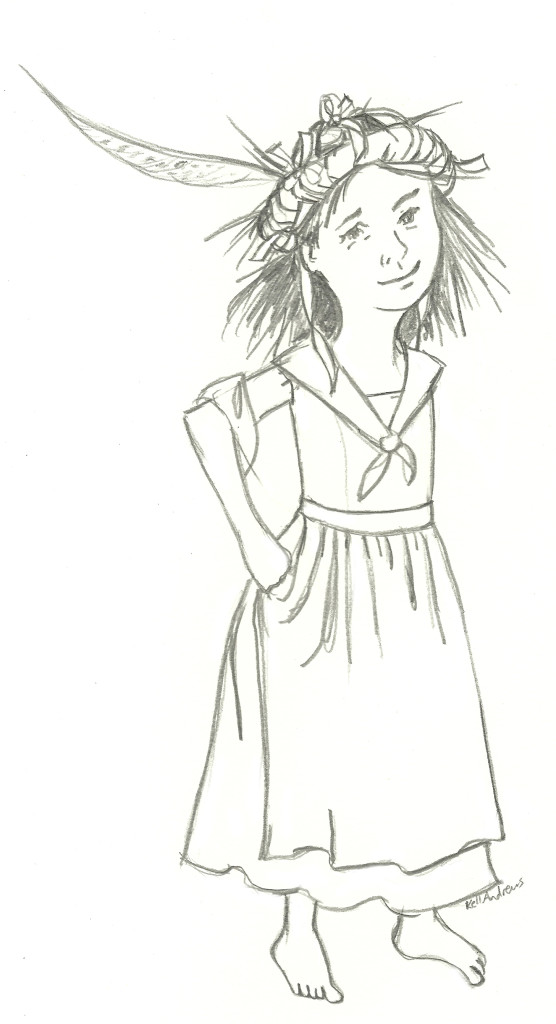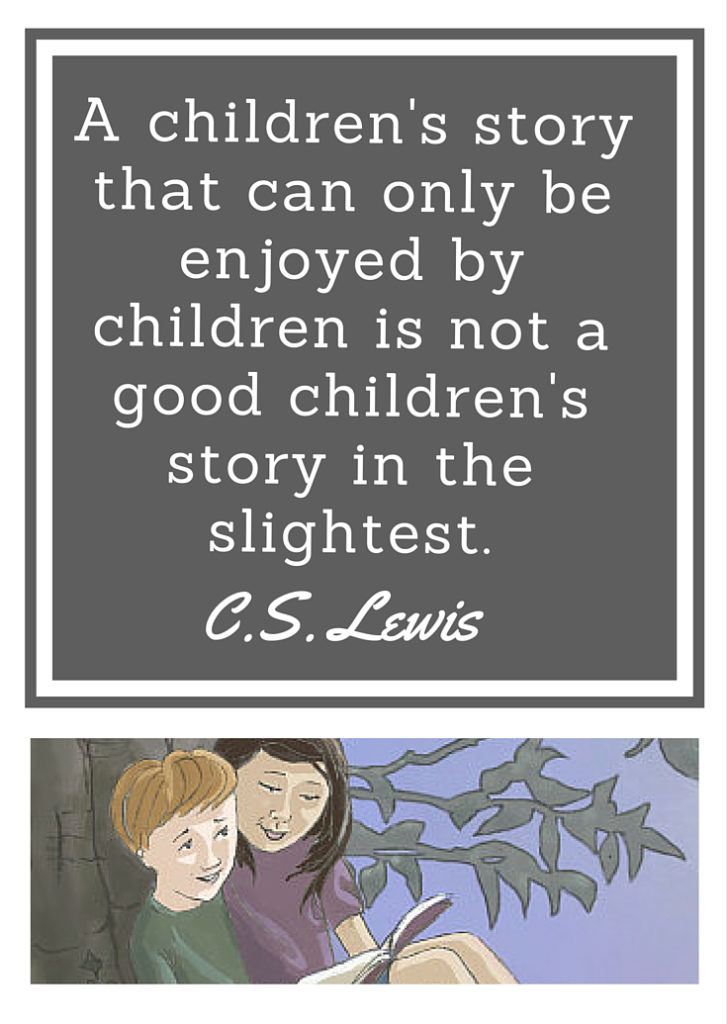 Sometimes I can’t exactly picture my characters. I can describe how they feel and what they do, but their faces are a bit soft focus. This character’s face came in loud and clear, so I drew her.
Sometimes I can’t exactly picture my characters. I can describe how they feel and what they do, but their faces are a bit soft focus. This character’s face came in loud and clear, so I drew her.

 The other day my family and I was listening to an audiobook during a car ride — a middle-grade fantasy that retells a Grimm fairy tale. And of course, the princess’s father died right in the beginning.
The other day my family and I was listening to an audiobook during a car ride — a middle-grade fantasy that retells a Grimm fairy tale. And of course, the princess’s father died right in the beginning.
My husband complained — he’s tired of all the dead parents of children’s literature. I defended the plot because that’s how stories work. Happy lives make dull books. The main character has to act on her own. She must suffer before she triumphs. She must face conflict.
Still, like my husband, I have tried to shelter my children from some literary losses — we haven’t read Charlotte’s Web or The Bridge to Terabithia. We never watched Bambi. We haven’t read the gruesomest Grimm tales that fascinated me as a child — the murdered stepson served as stew, the barrel studded inside with nails.
I remember my daughter flipping through my copy of Sing-Song, A Nursery Rhyme Book by Christina Rossetti. She was attracted by the little girl on the cover cavorting with a lamb, one of the gorgeous original illustrations by Arthur Hughes, the Pre-Raphaelite whose illustrations for George MacDonald’s The Princess and the Goblin.
Read the rest of the post on Project Mayhem >>
I’m so honored that DEADWOOD has made it to the second and final voting round of the 2015 SCBWI Crystal Kite Awards. The SCBWI is the Society of Children’s Book Writers and Illustrators, and I’m in the Atlantic division (Pennsylvania, Delaware, New Jersey, Washington DC, Virginia, West Virginia, Maryland). The Crystal Kites are member-voted awards, and I’m thankful for the support of my SCBWI peers.
If you’re an SCBWI member, vote for books in your division from April 18 – 30.
Books for children are the ones most likely to be challenged based on content. If parents are to decide for their children which books are appropriate, that means that “inappropriate” books can and should be published so all parents have that choice.

While everyone in the Northeast is glued to weather reports, it’s the perfect time to announce that my weather-prognosticating picture book will be released in 2016 by Sterling Children’s Books. Here’s the announcement from today’s Publishers Marketplace:
There are no snow storms in my book — Mira Tells the Future is a summery story about a young would-be boardwalk fortuneteller who saves her beach town by using meteorology, instead of clairvoyance, to predict the weather. I’ve had such fun working with my wonderful editor Zaneta Jung on this book, and I can’t wait to see what an illustrator does with it. Thanks always to my agent, Kathleen Rushall, who saw Mira’s potential — I suspect she has a crystal ball of her own.
Think warm thoughts, everyone!
I’m working on a new novel, one that I have outlined in a synopsis but no further. I have a clear creative vision, but not a clear outline. I have novels that have been waylaid in the process of outlining, where I couldn’t solve a plot point and then the whole thing fell apart. As much as outlines have helped me in the past, this time I’m using the Headlight Method, which I first learned of in James Scott Bell’s indispensable reference, Plot & Structure.
E.L. Doctorow is credited with the saying, “Writing is like driving a car at night. You can only see as far as the headlights, but you make the whole trip that way.”
Neither pantser nor plotter am I, but something between. I need to see the next step, but if I have to have every detail done, I will never be done.
In the Headlight Method, you only need see as far as what’s in your headlights — you write scene by scene. When you get to the end of each, ask what next? What is the character’s emotional state? What is the next action the character needs to take?
I have a synopsis; I know where I’m going. I use the Headlight Method for what’s next.
This is going to be my approach to plotting but also writing goals, and other goals for 2015 too. When I have think about how long it will take me to write 100,000 words, I’m daunted. But I can think about 10K words, I can see my way to what’s next. Similarly, if I have to think about how to achieve a long-term health goal or a large financial goal, I’m overwhelmed. But if I can plan until the end of this month, I can be ready for next month.
So instead of New Year’s Resolutions or New Year’s goals, I have goals for what’s next in my headlights — for this month, this week, or today.
Or perhaps just next 30 minutes for a writing sprint to get in another 500 words or another scene. Then I’m ready for what’s next.
More explanation of the Headlights Method:
How to Outline a Novel Using the Headlights Method
 I spent far too long making a new header illustration for my site. I was aiming for a more flexible design that works for both middle grade and picture book writing. The color palette was inspired by my writer friend Colby Marshall. Colby has color-grapheme synthesia, like the main character of her much-praised new thriller Color Blind. While Dr. Jenna Ramey is a forensic psychiatrist who uses her unique way of interpreting the world to help solve crimes, Colby was kind enough to answer me when I demanded to know what color I am. She said periwinkle, and that color dominated this twilight design.
I spent far too long making a new header illustration for my site. I was aiming for a more flexible design that works for both middle grade and picture book writing. The color palette was inspired by my writer friend Colby Marshall. Colby has color-grapheme synthesia, like the main character of her much-praised new thriller Color Blind. While Dr. Jenna Ramey is a forensic psychiatrist who uses her unique way of interpreting the world to help solve crimes, Colby was kind enough to answer me when I demanded to know what color I am. She said periwinkle, and that color dominated this twilight design.
Note that the trees in the design are still American beeches — the same kind of tree that stars in Deadwood, although these are a little more at peace. Please let me know what you think.
I spent the day cleaning the house. This one:

Earlier this month I visited Tyler Arboretum in Media, PA, and acquired a new hobby. I was with my kids so I spent nearly as much time in the gift shop as in the fabulous treehouses, and I picked up a copy of Big Trees of Pennsylvania. Tyler Arboretum is home to quit a few Champion Trees — the largest of their kind in Pennsylvania, including one of the largest PA trees of any kind — a mammoth tulip poplar (Liriondendron tulipifera) 133 feet tall.
I missed that tree while climbing Tyler’s gorgeous treehouses and coaxing my youngest daughter to keep walking, but now I’m planning to visit and document more of Pennsylvania’s biggest trees, as tracked by PAbigtrees.com.
What makes a Champion Tree? Trees are tracked by species and accrue points as follows:
Trunk circumference: Measured 4.5 feed about the ground level, one point accorded per inch.
Height: One point per foot, measured with a clinometer, hand level, or range finder.
Crown spread: 1/4 point per foot of the average between the smallest and widest crown spread.
It’s hard to recognize a Champion just by looking because they are species-specific. The largest tree in Pennsylvania overall is a Mercersburg American Sycamore (Plantanus occidentalis) with a whopping 529 points, but the largest crabapple is only 84. So I’m not going to be identifying them, unless I get extremely lucky, but looking at them in their environment.
Visit my tree blog, treeandtwig.tumblr.com for:
Proof that I am not my books: We are often seen at the same place at the same time.
I put a lot of myself into the books I write. The characters come out of my head — the protagonists, antagonists, comic relief, parents good and bad, the passerby on the street who only has one line. But they are not me.
The dialogue comes from my head — philosophizing, wisecracking, both sides of an argument. But it’s not what I would say.
The writing, rewriting, querying, submission, editing, and marketing of a book takes a lot of time, emotion, and thought. There is a lot of my life and myself in my books. I have a creative vision, and it comes out in my books. But they are not me.